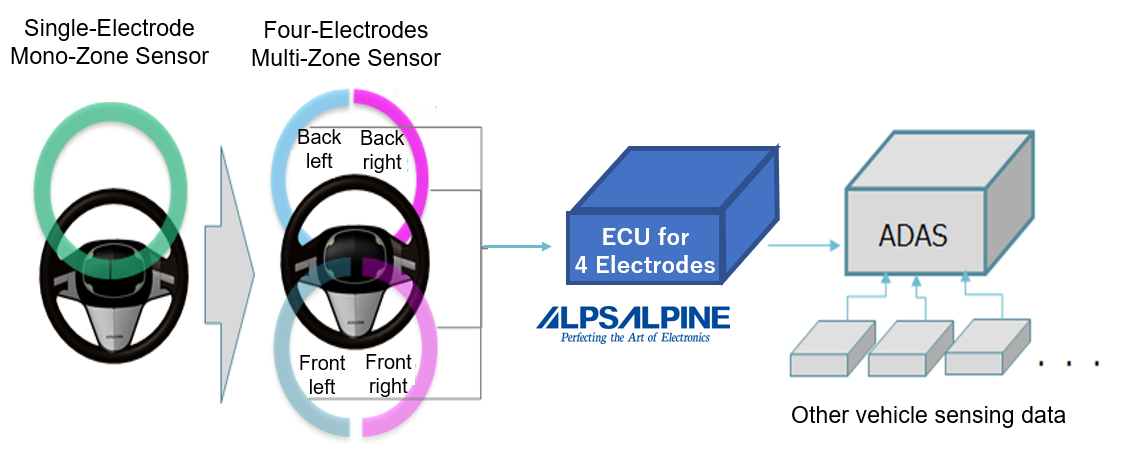Four-Electrode Multi-Zone Configuration Distinguishes Between Driver Grip Variations for Safer Mobility
Munich, Germany, July 16, 2021 – Alps Alpine has a developed an electronic control unit (ECU)1 for hands-off detection to support autonomous driving systems by distinguishing between variations in a driver’s grip on the steering wheel. Mass production began in spring 2021 and the plan is to gradually expand deployment to a range of vehicle models. To accommodate advancements in autonomous driving support and further contribute to safe and comfortable mobility, development for next-generation models is already underway.
Background to the Development
Technological innovation is gathering speed within the automotive CASE domains of connected cars, autonomous driving, sharing and services, and electrification. In the field of autonomous driving, we see growing deployment of systems that enable a vehicle, under certain conditions, to automatically follow the car in front while keeping to the lane. One recently developed advanced autonomous driving system now on the market performs all driving tasks under limited scenarios, such as while traveling on an expressway or at low speeds.
Vehicles equipped with these features need to be able to detect and assess a driver’s driving status to allow safe and smooth switching between automated and manual driving. One aspect is hands-off detection, a function for determining the status of the driver’s grip on the steering wheel that interacts with other systems for assessing driving status to enable safe switching between driver-controlled and system-controlled modes. Safety features are necessary given the ongoing sophistication of autonomous driving assistance systems, and legislation is progressing. Provisions under the R79 international regulation are one example.
Determining the right time to switch between autonomous driving assistance and manual driving requires constant monitoring of the vehicle’s drive status and the driver’s driving posture to ensure safety. If the continuation of autonomous driving assistance is deemed inappropriate, the driver needs to be quickly warned that the assistance is to be disengaged and urged to immediately revert to manual driving. Safety assurances demand much more precise detection of diverse variations of the driver’s grip on the steering wheel.
Outline of the Development
1. System Configuration
Capacitive sensing is the dominant technology used for steering wheel touch detection due to its cost and functional performance. The ECU uses data obtained via a special-purpose capacitive sensor, wrapped around the steering wheel, to determine if the driver is touching it and conveys the assessment to an advanced driver assistance system (ADAS). Whereas existing hands-off detection systems are mono-zone setups, with a single electrode, Alps Alpine has developed a multi-zone configuration with four electrodes (see Fig. 1). Dividing the steering wheel and grip patterns into smaller sections enables efficient system switching and enhanced touch assessment reliability.
2. Product Outline
Resilience to physical stress is a necessary consideration when employing capacitive control, as is the need to maintain resistance to environmental factors – temperature, humidity and electromagnetic noise – and the feel of the sensor itself. It is also essential to have separate, optimal control for sensor materials specific to the application. Alps Alpine started producing touch panels for notebook PCs and game consoles in the 1990s and automotive control panels for capacitive touch-type in-vehicle infotainment (IVI) systems in the 2010s. The company has plenty of experience applying capacitive control technology to a diverse range of sensor materials and environments spanning product domains from consumer electronics to automobiles. Utilizing this knowledge, we have developed a hands-off detection ECU for use with a special-purpose steering wheel capacitive sensor. Deliveries to steering wheel manufacturers began in spring 2021.















